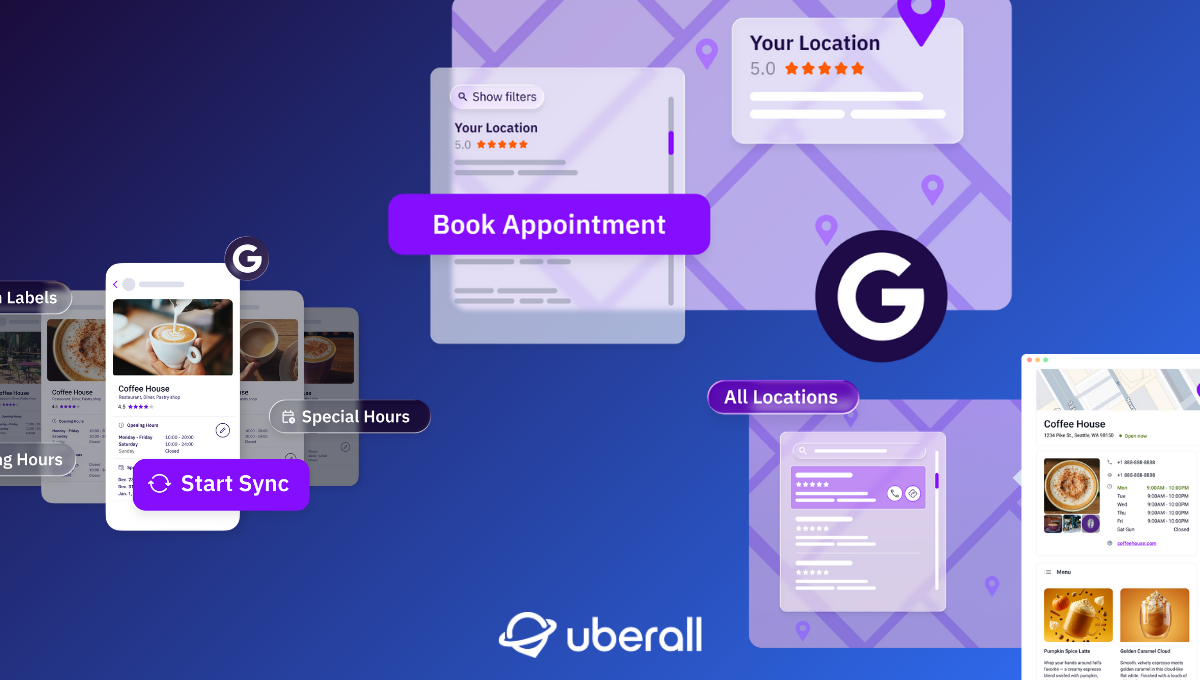
The Dance of Demand: How to Optimize for Seasonal Web Traffic
Get your local SEO ducks in a row and don’t let seasonal web traffic periods catch you unaware – because you can optimize for both high and low demand!
It is both a curse and a blessing that the biggest boom times for retail and hospitality all tend to huddle together. From Black Friday through to the Christmas rush and end-of-year sales, both sectors thrive on the increased attention and foot traffic from busy consumers tackling their holiday to-do lists.
Once the festivities wrap up, though, a lull inevitably follows, creating a stark contrast to the previous hustle and bustle. But these seasonal changes not only impact foot traffic, but also organic web traffic as more (or less) customers search for the latest products or services online.
Although every business should expect natural ebbs and flows in overall web traffic, understanding exactly how that traffic oscillates over the course of the seasons allows you to anticipate project planning for slower times while preparing for busier seasons.
In this blog article, we explore the sources of seasonal traffic and offer tips on how to maximize its potential, along with insights on when to expect peak and low traffic times.
The Truth About Seasonal Web Traffic
When we say “seasonal web traffic” we’re not just talking about any single festive season or retail holiday. We’re also considering broader seasonal shifts like summer and winterthat encompass festive events—think Halloween, New Year’s Eve, and Valentine’s Day—while reflecting significant trends in consumer behavior throughout the year.
It’s important, though, to recognize a big difference between B2C and B2B: while people eagerly shop for personal items and gifts during holidays, business purchases are usually put on hold until after the festivities.
New Year Traffic
At the start of the year, most businesses experience a significant dip in web traffic as consumers recover from holiday spending and adopt a more cautious approach to shopping.
However, this period also coincides with the rise of New Year's resolutions, which offers opportunities for fitness, health, and self-improvement businesses to attract more visitors. Expect some positive changes in traffic that may extend into February, but watch for a drop in March.
Early Spring Traffic
Spring officially begins in March, but web traffic can be unpredictable during this time. March and April may feel like a roller coaster ride with significant fluctuations.
Keep in mind that many people are on spring break or focused on exam preparations, which can limit their online shopping. If you navigate these months successfully, you’re likely to see a boost in traffic come May and June.
Late Spring/Early Summer Traffic
As May arrives, businesses often enjoy a surge in sales or stable traffic, a welcome relief for those who faced declines in early spring. This trend typically continues through June before dipping again in late summer, which is the summer holiday season.
Late Summer Traffic
Traffic tends to slow down in late summer as many individuals take vacations and enjoy time off from school. While some industries, like swimming pools and recreation, might see positive changes, most businesses will experience a lull. Use this downtime to gear up for the upcoming traffic surge.
Fall Traffic
Fall brings renewed productivity for many businesses, particularly those offering B2B products and services. September and October serve as a critical period before winter sets in, as shoppers begin their holiday shopping. It’s crucial to prepare for holiday traffic starting in October.
Winter/Holiday Traffic
From November onwards, expect to see a significant uptick in web traffic as shoppers hunt for enticing deals and promotions. Make sure to communicate shipping deadlines clearly to ensure timely delivery for holiday gifts, and consider offering expedited shipping for last-minute shoppers.
What Influences Seasonal Web Traffic Most?
Some products and services remain in demand year-round, while others call for closer attention to the whims of the market, or careful examination of consumer activity at the market level. So analyzing and optimizing for seasonal web traffic prepares you to position your business dynamically, and to tap into your local audiences’ needs at their peak.
Seasonal Web Traffic Example
A florist might find a seasonal spike just before Valentine’s Day, while outdoor equipment retailers could boom around summer as people seek camping gear. Conversely, that same camping equipment retailer is unlikely to have sales booms in the depths of mid-winter – which could be why many also offer snow equipment as part of their inventory.
If nothing else, slow web traffic periods provide you a great opportunity to analyze newly acquired data, gather customer feedback, debrief with staff, and conduct cost-benefit analyses in preparation for the next high search traffic season.
Seasonal Web Traffic Analysis
Deploying traffic forecasting tools and understanding web traffic trends on larger and finer scales provides better modeling for your business to manage cash flow and product development as you weather established slow traffic periods. But the biggest reason to track your online traffic is better data, which helps you see when your business can thrive, not just survive, with plenty of notice throughout the year.
Mapping out regular patterns in web traffic trends to understand those high vs low traffic seasons reduces the shock for multi-location marketers rolling with the punches while mapping out projections for online visibility:
- Your own website stats will show any traffic spikes during holidays as well as slow web traffic periods.
- Google Trends helps you identify consumer behavior changes associated with interest in certain keywords or terms.
- SEMrush or Ahrefs allows you to conduct benchmark analysis and understand how seasonal trends affect your competitors’ traffic.
As you evaluate online traffic data, look at year-on-year (YoY) traffic to compare apples with apples. For seasonal web traffic trends, you would want to check month-by-month (MoM) results, though, to highlight seasonal factors more accurately.
Taking retail as an example
At larger scales, retailers tend to track overall traffic spikes during holidays. For one, when the sun is shining and everyone moves outside, consumers tend towards more spontaneous local purchasing decisions—so they are more likely to find themselves performing “near me” searches that are so important to local SEO. Also, holidays like Christmas or Easter inspire higher spending, whether it's for gifts for others or a little extra for oneself
During post-holiday periods, however, retail often experiences a significant dip in traffic as consumers recover from their spending, leading to quieter shopping days until the next peak season arrives.
But it bears repeating: While you cannot and should not expect to always predict exactly what will happen, looking at historical web traffic trends per each season and developing seasonal digital marketing strategies can help make sure your products and services show up at the right time for the right people.
How to Capitalize on Holiday Web Traffic Fluctuations
None of the insights above means you should simply accept those slow web traffic periods as facts of life. By using traffic forecasting tools, you can create holiday marketing campaigns that continue to manifest online visibility well beyond their intended season.
Many businesses offer promotions or discounts to match the seasons, not least of which summer sales in retail shopping environments. For example, Spirit Halloween has built an entire pop-up business model around seasonal changes. Just remember that keeping these offers consistent year after year can build customer expectations – so if you start, you can’t just stop.
When planning product launches, seasonal trends play a crucial role in timing and messaging, too. Industries often align launches with peak traffic periods, such as holidays or back-to-school seasons, to maximize exposure and meet customers when they’re most likely to be ready to purchase. For example, fashion brands might launch their summer collections just as warmer months approach (not after they’ve arrived), ensuring shoppers have time to purchase items in anticipation.
The key takeaway
Understanding web traffic trends allows you to start planning your marketing campaigns months in advance, with plenty of advance notice on what to expect over the course of development and deployment.
What About Seasonal Search Engine Optimization?
Well-considered seasonal SEO strategies align your optimization with the natural tides of consumer interest over the course of the fiscal year. But the question remains: How can you lead consumers to find your business, much less capture those users’ attention?
Designing and shepherding durable real-time marketing strategies alongside longer term seasonal digital marketing strategies opens the way to seizing those opportunities and making the most of trending topics.
First, dig into your website’s historical data, looking for peaks in conversion rates and keyword popularity by season – and don’t forget to look at any regional variations across your locations, too.
Second, plan content and holiday marketing campaigns that deploy findings organically to improve your local search ranking for those queries. For example, create blog posts about seasonal trends, update your product descriptions, build local landing pages or redesign parts of your websites to position yourself within the seasonal spirit.
Third, building an active social media presence that highlights seasonal themes can help draw attention to your brand, as well as boost SEO through shares and engagement. Also, consider running targeted ad campaigns timed around peak seasons and holidays to bring in a steady stream of traffic.
Best Practices for Retaining Engagement During Low-Traffic Seasons
Once you zero in on the right collection of indicators and get on tracking traffic spikes during holidays and the slow web traffic periods, you can create more informed seasonal digital marketing strategies – like these:
- An ice cream parlor might run an “Autumn Flavors” campaign in late fall, introducing limited-time flavors like pumpkin spice or apple pie to encourage customers before the cold winter months slow business.
- A home heating company could run a campaign during the summer – when there’s usually low traffic – urging customers to check their boilers early; because proactive maintenance can prevent costly repairs when cold weather hits.
- A wellness center might promote a “spring refresh” campaign, encouraging clients to book detox treatments and skin care services to rejuvenate after winter – which prepares the spa for an influx of bookings as people get ready for warmer weather.
All these bring a range of benefits: maximizes revenue when traffic peaks, keep your pipeline active during slow months, and ensure preparation for high-demand periods.
Riding out Seasonal Web Traffic Storms with Data-Driven Marketing Strategies
Maintaining a data-driven marketing strategy proves essential to long-term success in the face of seasonal traffic trends – because leveraging seasonal web traffic trends enables businesses to accomplish much more than simply adjusting their services appropriately to meet real demand.
Staying on top of the highs as well as the lows mitigates the serious risks of losing online traffic to savvy competitors more equipped to meet those seasonal demands. That means meeting customers where they are and also when they are looking, at the right time to move them down your funnel.
With consumers craving real in-person experiences that can’t be replicated online and projecting a “post-pandemic” buyers’ mindset, Forbes already declared that “the holiday 2024 shopping season will be unlike any other” on a broad scale. Well-timed campaigns built on deeply local SEO provide tickets to those golden opportunities.
Our advice: Get your local SEO ducks in a row and don’t let slow web traffic periods catch you unaware. Get in touch and discover how Uberall can help you build stronger seasonal SEO strategies for more effective marketing campaigns – without the holiday stress.
Ready to Transform Your Business?
Connect with our partnership team to learn how Uberall can help you achieve similar results. Get a personalized consultation and discover the opportunities waiting for your business.
Resources











